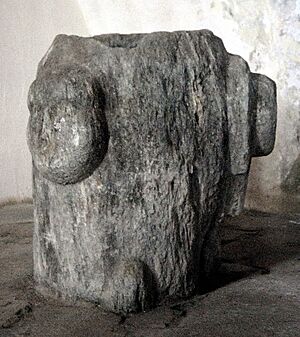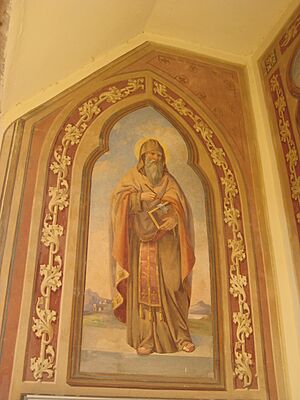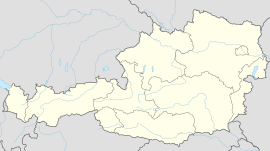Magdalensberg facts for kids
Quick facts for kids
Magdalensberg
|
||
|---|---|---|
|
||
| Country | Austria | |
| State | Carinthia | |
| District | Klagenfurt-Land | |
| Area | ||
| • Total | 42.9 km2 (16.6 sq mi) | |
| Elevation | 450 m (1,480 ft) | |
| Time zone | UTC+1 (CET) | |
| • Summer (DST) | UTC+2 (CEST) | |
| Postal code |
9064
|
|
| Area code | 04224 | |
Magdalensberg (in Slovene: Štalenska gora) is a market town in Austria. It is located in the Klagenfurt-Land district, which is part of the Carinthia state.
Contents
Discover Magdalensberg's Location
Magdalensberg is found at the base of a mountain also called Magdalensberg. This area is part of the Klagenfurt basin. It is also in the lower Gurk valley. Two rivers, the Gurk and the Raba, flow through this town.
The town is made up of 40 smaller villages and hamlets. Some of these include Christofberg, Deinsdorf, and Magdalensberg itself. There are also 13 cadastral subdivisions, which are like land registry areas. All these villages also have names in the Slovenian language.
Understanding the Name of Magdalensberg
The town of Magdalensberg gets its name from the mountain it sits near. "Magdalene's Mountain" is what the name means. This mountain is famous for an old Celtic settlement found on its top. People believe this settlement might have been the capital city of the Celtic kingdom of Noricum.
Archaeologists have been digging here for over a hundred years. So far, they haven't found clear signs of the Celtic town. This might be because the Romans later built a new city, Virunum, at the foot of the mountain. The Romans started building around 50 BC. They might have changed the old Celtic settlement a lot. We still don't know the original name of the Celtic town. Some think the Roman city of Virunum might have taken its name from the older Celtic site.
The Famous Youth of Magdalensberg Statue
In 1502, a very important discovery was made here. It was a perfect statue of a young man. This beautiful statue was first called the "Jüngling vom Helenenberg." This was because the mountain was then known as Helenenberg. The statue became famous across Europe. It was seen as one of the best examples of Greek sculpture in the region.
The original statue is now kept in the Vienna Museum of Art. For tourism, the statue was renamed "Jüngling vom Magdalensberg." You can see copies of this statue in the Magdalensberg museum and in Klagenfurt. Experts later found out that the "original" statue was actually a Roman copy of an even older Greek statue from the 5th century BC. More recently, it was discovered that the statue we have is an early Renaissance copy of a Roman copy. The true original Greek and Roman copies are now lost.

Magdalensberg in the Roman Empire
The region of Noricum was a friend and ally of Rome during the time of the Roman Republic. They traded a lot with each other. Noricum provided iron, gold, and farm products to Rome.
The trading center at Magdalensberg had two main parts. There was a native settlement on top of the mountain. Below it was a Roman trading area. The mountain settlement was the main center for the Noricum kingdom. It was also where the royal family lived. This made it a natural place for Roman merchants to come and trade.
The Roman trading area grew on a sunny terrace below the mountain. The first buildings were made of wood around 100 BC. By 30 BC, the traders' houses were built from stone. These houses had paintings of Roman myths on their walls. These paintings were done by Roman artists who moved there. The main part of the Roman area was a large open space called a forum. This is where all the trading happened.
Roman merchants from big business families, mostly from Aquileia, lived and worked here. They brought their Roman way of life with them. The large amount of trade with Rome helped local production grow. It also introduced the Roman lifestyle to the local people. Over time, the people of Noricum started to enjoy Roman luxuries and adopted Roman customs more and more.

Magdalensberg's Slovenian History
This area is also very important for the cultural history of the Slovenians. Many settlements here came from an old Slavic social system. This system included people called kosezi, who were later known in German as Edlinger. These kosezi were the ones who chose the prince of the State of Carantania. The center of Carantania was nearby, in the village of Karnburg (in Slovene: Krnski grad).
The central mountain hill was also a religious center for the Slavs and Carantanians. A local expert, Pavle Zablatnik, believes that a special pilgrimage on four hills, starting from Magdalensberg mountain, was practiced before Christianity arrived. This means it was first adapted into Slavic culture before it became a Christian tradition.
The three-headed stone from Magdalensberg is also very important. It is believed to be a great example of early Slavic art from the 8th to mid-9th century. It shows how the main Slavic god, Triglav (the three-headed god), was represented. If it hadn't been adapted in this way, it might have been destroyed when Christianity first came to the Slovenes. Even though the Slovenian language is now a minority language here, many signs of Slovenian cultural history still remain.
People from Magdalensberg
- Ottmanach is one of the villages in Magdalensberg. It was the first home of the famous singer and composer Udo Jürgens.
- Zinsdorf, another village in Magdalensberg, is where the linguist Katja Sturm-Schnabl was born.
See also
 In Spanish: Magdalensberg para niños
In Spanish: Magdalensberg para niños



